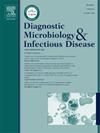上海某幼儿园诺瓦克病毒GII.17暴发的流行病学和分子调查
IF 1.8
4区 医学
Q3 INFECTIOUS DISEASES
Diagnostic microbiology and infectious disease
Pub Date : 2025-08-29
DOI:10.1016/j.diagmicrobio.2025.117089
引用次数: 0
摘要
诺如病毒(NoV)是全球范围内导致人类非细菌性急性胃肠炎(AGE)的最常见病原体之一。方法对2024年9月发生在上海市某幼儿园的诺如病毒疫情进行流行病学调查和病原学分析,为今后预防和控制类似事件提供参考。结果本次疫情共报告呕吐腹泻9例,涉及同一班级8名学生和1名教师。症状的出现集中在9月26日至28日。核酸检测发现3例肛门拭子样本中存在诺如病毒GⅡ阳性,基因分型证实存在GII.17诺如病毒。此外,发现病毒株在该基因的RdRp区和VP1区高度同源。进化分析表明,此次暴发的分离株与2022-2024年在欧洲和美国流行的菌株具有高度同源性。结论有必要加强诺如病毒GII.17基因型VP1区的分子进化研究,防止出现可能造成严重损害的新变异。本文章由计算机程序翻译,如有差异,请以英文原文为准。
Epidemiological and molecular investigation of a norovirus GII.17 outbreak in a kindergarten in Shanghai, China
Introduction
Norovirus (NoV) is among the most prevalent pathogens responsible for non-bacterial acute gastroenteritis (AGE) in humans on a global scale.
Methodology
In September 2024, an epidemiological investigation and etiological analysis of a norovirus outbreak at a kindergarten in Shanghai Municipality of China was conducted to provide insights for preventing and controlling similar incidents in the future.
Results
A total of nine cases of vomiting and diarrhea were reported in the outbreak, involving eight students and one teacher in the same class. The onset of symptoms was concentrated from 26 to 28 September. Nucleic acid tests detected the presence of the norovirus GⅡ positive in the anal swab samples of three cases, and Genotyping confirmed the presence of the GII.17 norovirus. Furthermore, the virus strains were found to be highly homologous in the RdRp region and VP1 region of the gene. Evolutionary analysis showed that the isolates from this outbreak had high homology with the strains circulating in Europe and the United States in 2022-2024.
Conclusions
It is necessary to strengthen the research on the molecular evolution of VP1 region of norovirus GII.17 genotype to prevent the emergence of new variants that could cause serious damage.
求助全文
通过发布文献求助,成功后即可免费获取论文全文。
去求助
来源期刊
CiteScore
5.30
自引率
3.40%
发文量
149
审稿时长
56 days
期刊介绍:
Diagnostic Microbiology and Infectious Disease keeps you informed of the latest developments in clinical microbiology and the diagnosis and treatment of infectious diseases. Packed with rigorously peer-reviewed articles and studies in bacteriology, immunology, immunoserology, infectious diseases, mycology, parasitology, and virology, the journal examines new procedures, unusual cases, controversial issues, and important new literature. Diagnostic Microbiology and Infectious Disease distinguished independent editorial board, consisting of experts from many medical specialties, ensures you extensive and authoritative coverage.

 求助内容:
求助内容: 应助结果提醒方式:
应助结果提醒方式:


